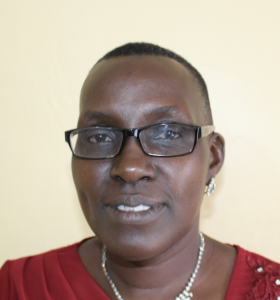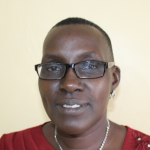It was a cold morning as we first journeyed to visit Asumani Spring in Bukhaywa. Once we arrived, it began to rain and wouldn't stop for several hours. Since this is the rainy season, we were prepared with an umbrella.
245 people rely on Asumani Spring to get water for drinking, cooking, and cleaning. The water is extremely dirty. Community members piled sand, stones, and grass behind where the water flows to try and shield it from contamination. In between the stones they added a pipe to help them fill their containers. Unfortunately, the water still carries particles of dirt - especially during and after rainy weather.
Community members suffer from typhoid; coughs and stomachaches are constant after drinking the dirty water from Asumani Spring. A lot of money has been spent getting medication for treatment.
"Protecting of our spring will help us improve on treating waterborne diseases and spending a lot of money," said Roselyne.
This is a rural location and it is very peaceful. It is vegetated with maize, beans and various vegetables. Houses made of mud and grass are among these farms.
Farmers sell their produce to make a living, and some men own motorbikes that they have dedicated to taxiing. Men wake up and leave with their motorbikes immediately, while women stay back and get the kids ready for school. Once the children are off, any other adults will go to work on the farm.
What we can do:
Training
"Our people perish because of lack of knowledge. If we acquire knowledge on good hygiene practice, we will improve on hygiene," said Omari Tembla.
In this community, there are some people with dish racks and others with latrines. They clear out the brush from around their homes. However, their water containers were dirty and people admitted to not cleaning them often.
Community members will attend hygiene and sanitation training for at least two days. This training will ensure participants have the knowledge they need about healthy practices and their importance. The facilitator plans to use PHAST (Participatory Hygiene and Sanitation Transformation), CLTS (Community-Led Total Sanitation), ABCD (Asset-Based Community Development), group discussions, handouts, and demonstrations at the spring. One of the most important topics we plan to cover is the handling, storage, and treatment of water. Having a clean water source will be extremely helpful, but it is useless if water gets contaminated by the time it’s consumed. Handwashing will also be a big topic.
Training will also result in the formation of a committee that will oversee operations and maintenance at the spring. They will enforce proper behavior around the spring and delegate tasks that will help preserve the site, such as building a fence and digging proper drainage. The fence will keep out destructive animals, and the drainage will keep the area’s mosquito population at a minimum.
Sanitation Platforms
Less than half of the families using Asumani Spring have a private place to use the bathroom.
On the final day of training, participants will select five families that should benefit from new concrete latrine floors.
Training will also inform the community and selected families on what they need to contribute to make this project a success. They must mobilize locally available materials, such as bricks, clean sand, hardcore, and ballast. The five families chosen for sanitation platforms must prepare by sinking a pit for the sanitation platforms to be placed over. All community members must work together to make sure that accommodations and food are always provided for the work teams.
Spring Protection
The community has done their best to get safe water, but they need the expertise and direction of artisans to get the job done right. They also need the proper tools and materials!
Properly protecting the spring will ensure that water is safe, adequate and secure. Construction will keep surface runoff and other contaminants out of the water. With the community’s high involvement in the process, there should be a good sense of responsibility and ownership for the new clean water source.
Fetching water is predominantly a female role, done by both women and young girls. Protecting the spring and offering training and support will, therefore, help empower the female members of the community by giving them more time and efforts to engage and invest in income-generating activities.

 Protected Spring
Protected Spring
 Rehabilitation Project
Rehabilitation Project






































